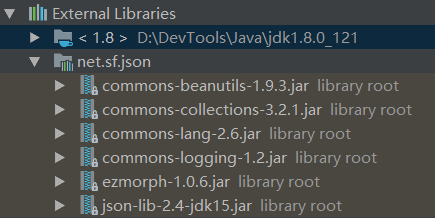net.sf.json - put、accumulate、element
阿新 • • 發佈:2017-11-03
rip object 一個 clas package args 之間 對象 src
net.sf.json 需要的 jar:

註意版本,部分版本之間會沖突。
package com.ikoo;
import net.sf.json.JSON;
import net.sf.json.JSONArray;
import net.sf.json.JSONObject;
public class TestJSON {
public static void main(String[] args) {
JSONObject jsonObject = new JSONObject();
JSONArray jsonArray = new JSONArray();
/**
* public Object put(Object key, Object value)
* 將value映射到key下
* 如果此JSONObject對象之前存在一個value在這個key下,那麽當前的value會替換掉之前的value
*/
jsonObject.put("one", "first");
// jsonObject: {"one":"first"}
System.out.println("jsonObject: " + jsonObject.toString());
jsonObject.put("two", "second");
// jsonObject: {"one":"first","two":"second"}
System.out.println("jsonObject: " + jsonObject.toString());
jsonObject.put("two", "cover");
// jsonObject: {"one":"first","two":"cover"}
System.out.println("jsonObject: " + jsonObject.toString());
jsonObject.put("one", null);// value為null的話,直接移除key
// jsonObject: {"two":"cover"}
System.out.println("jsonObject: " + jsonObject.toString());
/**
* public JSONObject accumulate(String key, Object value)
* 累積value到這個key下
* 1.如果當前已經存在一個value在這個key下,那麽會有一個JSONArray將存儲在這個key下來保存所有累積的value
* 2.如果已經存在一個JSONArray,那麽當前的value就會添加到這個JSONArray中
*
*/
JSONObject jsonObj = new JSONObject();
jsonObj.accumulate("Servers", null);// 允許value為null
jsonObj.accumulate("Servers", "Tomcat");
jsonObj.put("Codes", "Java");
jsonObj.accumulate("Codes", "JavaScript");
// jsonObj: {"Servers":[null,"Tomcat"],"Codes":["Java","JavaScript"]}
System.out.println("jsonObj: " + jsonObj.toString());
/**
* public JSONObject element(String key, Object value)
*/
JSONObject object = new JSONObject();
object.element("price", "500");
object.element("price", "1000");
// object: {"price":"1000"} 疑問: 這和put有何區別??? 說好的會調用accumulate呢???
System.out.println("object: " + object.toString());
}
}控制臺打印:
jsonObject: {"one":"first"}
jsonObject: {"one":"first","two":"second"}
jsonObject: {"one":"first","two":"cover"}
jsonObject: {"two":"cover"}
jsonObj: {"Servers":[null,"Tomcat"],"Codes":["Java","JavaScript"]}
object: {"price":"1000"}
P.S. 網上的帖子對 element 方法介紹都是如下:
Put a key/value pair in the JSONObject. If the value is null, then the key will be removed from the JSONObject if it is
present. If there is a previous value assigned to the key, it will call accumulate.
翻譯:
public JSONObject element (String key, Object value) 將鍵/值對放到這個JSONObject對象裏面。如果當前value為空(null),那麽如果這個key存在的話,這個key就會移除掉。如果這
個key之前有value值,那麽此方法會調用accumulate()方法。
但是,親測,卻不盡然,結果並不是如上的預期的效果。所以就納悶了,網上關於這樣的帖子好多,都是一樣的,想必是直接 CV 大法,不過我就是很納悶,為何 element 不是文檔說的那樣?!
net.sf.json - put、accumulate、element
